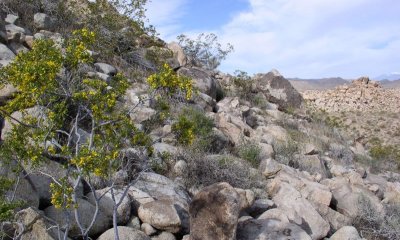
Warm Gravelly Shallow Hills
Scenario model
Current ecosystem state
Select a state
Management practices/drivers
Select a transition or restoration pathway
- Transition T1 More details
-
No transition or restoration pathway between the selected states has been described
Target ecosystem state
Select a state
Description
State 1 represents the historic range of variability for this ecological site. Primary natural disturbance mechanisms include drought and wildfire. This site is inherently resilient to disturbance due to a high cover of large surface fragments and rock outcrops which: 1. limits vegetation cover and biomass, thereby limiting the flammability of the site; 2. provides localized microsites in which the plant community is protected from fire which can then serve as propagule sources for recovery; and 3. provides additional run-on which promotes recovery after fire and provides refugia from drought (e.g. Green et al. 1993).
Historically, fire in this state would have been very rare, since adjacent communities, which drive the occurrence of fire in this ecological site, were much less likely to experience large fires. However, long periods of heavy precipitation could have promoted native annual growth such that fire (e.g. Brown and Minnich 1986) could be carried in adjacent plant communities, and spread to this ecological site.
Description
State 2 represents the current range of variability for this site. Non-native annuals including red brome, Mediterranean grass, and redstem stork's bill are naturalized in this plant community. Their abundance varies with precipitation, but they are at least sparsely present (as current year's growth or present in the soil seedbank). The ecological dynamics for the site have not changed significantly.
Submodel
Model keys
Briefcase
Add ecological sites and Major Land Resource Areas to your briefcase by clicking on the briefcase (![]() ) icon wherever it occurs. Drag and drop items to reorder. Cookies are used to store briefcase items between browsing sessions. Because of this, the number of items that can be added to your briefcase is limited, and briefcase items added on one device and browser cannot be accessed from another device or browser. Users who do not wish to place cookies on their devices should not use the briefcase tool. Briefcase cookies serve no other purpose than described here and are deleted whenever browsing history is cleared.
) icon wherever it occurs. Drag and drop items to reorder. Cookies are used to store briefcase items between browsing sessions. Because of this, the number of items that can be added to your briefcase is limited, and briefcase items added on one device and browser cannot be accessed from another device or browser. Users who do not wish to place cookies on their devices should not use the briefcase tool. Briefcase cookies serve no other purpose than described here and are deleted whenever browsing history is cleared.
Ecological sites
Major Land Resource Areas
The Ecosystem Dynamics Interpretive Tool is an information system framework developed by the USDA-ARS Jornada Experimental Range, USDA Natural Resources Conservation Service, and New Mexico State University.
